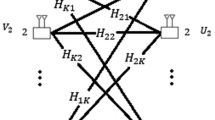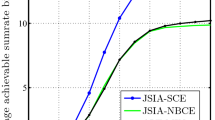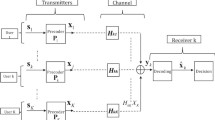Abstract
This paper studies the impact of channel error on the achievable rate of symmetrical K-user multiple-input multiple-output linear interference alignment (IA) networks. The upper and lower bounds of the achievable sum rate are derived analytically with the assumption of orthonormal transmit precoders and receive filters designed from imperfect channel state information (CSI) over both the uncorrelated and correlated channels. For uncorrelated channels, quite tight lower and upper bounds are obtained. The impact of channel error on the degrees of freedom (DoF) and the DoF persistence conditions are also investigated. Results show that the DoF of IA networks persists only if the channel error decreases in an order higher than the signal-to-noise ratio. For correlated channel, the lower and upper bounds for one realization of IA are derived. The derived upper bound can be used to characterize the achievable rate approximately. Simulation results indicate that the achievable rate of IA network is influenced significantly by CSI uncertainty. The obtained analytical bounds provide an intuitive way to show the impact of channel error on the achievable rate and thus can help practical systems deign.










Similar content being viewed by others
References
Cadambe, V. R., & Jafar, S. A. (2008). Interference alignment and degrees of freedom of the K-user interference channel. IEEE Transactions on Information Theory, 54(8), 3425–3441.
Maddah-Ali, M., Motahari, A., & Khandani, A. (2008). Communication over MIMO X channels: Interference alignment, decomposition, and performance analysis. IEEE Transactions on Information Theory, 54(8), 3457–3470.
Gomadam, K. S., Cadambe, V. R., & Jafar, S. A. (2011). A distributed numerical approach to interference alignment and applications to wireless interference networks. IEEE Transactions on Information Theory, 57(6), 3309–3322.
Shen, H., & Li, B. (2012). An iterative interference alignment scheme for the SISO interference channel. Wireless Personal Communications, 67(3), 707–720.
Yetis, C. M., Gou, T., Jafar, S. A., & Kayran, A. H. (2010). On feasibility of interference alignment in MIMO interference networks. IEEE Transactions on Signal Processing, 58(9), 4771–4782.
Akbari, M., & Falahati, A. (2014). Spatial-DoF improvement of MIMO cognitive network through interference fusion in conjunction with alignment. Wireless Personal Communications. doi:10.1007/s11277-014-2255-4.
Han, D., Hui, B., Chang, K., & Koo, B. (2013). Optimal reference vector selection algorithm in subspace interference alignment to maximize system throughput. Wireless Personal Communications, 71(2), 1085–1094.
Lee, N., & Heath Jr, R. W. (2013). Space-time interference alignment and degrees of freedom regions for the MISO broadcast channel with periodic CSI feedback. arXiv preprint arXiv:1308.3272.
de Kerret, P., Guillaud, M., & Gesbert, D. (2013). Degrees of freedom of certain interference alignment schemes with distributed CSIT. arXiv preprint arXiv:1305.1490.
Yi, X., Gesbert, D., Yang, S., & Kobayashi, M. (2012). The DoF region of the multiple-antenna time correlated interference channel with delayed CSIT. arXiv preprint arXiv:1204.3046.
Tresch, R., & Guillaud, M. (2009). Cellular Interference Alignment with Imperfect Channel Knowledge. In Proceedings of IEEE International Conference on Communication Workshops (pp. 1–5). Dresden, Germany.
Razavi, S. M., & Ratnarajah, T. (2014). Performance analysis of interference alignment under CSI mismatch. IEEE Transactions on Vehicular Technology, 63(9), 4740–4748.
Guiazon, R. F., Wong, K. K., & Wisely, D. (2014). Capacity analysis of interference alignment with bounded CSI uncertainty. IEEE Wireless Communications Letters, 3(5), 505–508. doi:10.1109/LWC.2014.2344656.
Guiazon, R. F., Wong, K. K., & Fitch, M. (2016). Capacity distribution for interference alignment with CSI errors and its applications. IEEE Transactions on Wireless Communications, 15(1), 1–10.
Chen, X., & Yuen, C. (2016). On interference alignment with imperfect CSI: Characterizations of outage probability, ergodic rate and symbol error rate. IEEE Transactions on Vehicular Technology, 65(1), 47–58.
Nosrat-Makouei, B., Andrews, J. G., & Heath, R. W, Jr. (2011). Mimo interference alignment over correlated channels with imperfect CSI. IEEE Transactions on Signal Processing, 59(6), 2783–2794.
El Ayach, O., Lozano, A., & Heath, R. W, Jr. (2012). On the overhead of interference alignment: Training, feedback, and cooperation. IEEE Transactions on Wireless Communications, 11(11), 4192–4203.
El Ayach, O., & Heath, R. W, Jr. (2012). Interference alignment with analog channel state feedback. IEEE Transactions on Wireless Communications, 11(2), 626–636.
Mungara, R., George, G., & Lozano, A. (2014). Overhead and spectral efficiency of pilot-assisted interference alignment in time-selective fading channels. IEEE Transactions on Wireless Communications, 13(9), 4884–4895.
Rezaee, M., & Guillaud, M. (2012). Interference alignment with quantized Grassmannian feedback in the \(K\)-user MIMO interference channel. arXiv preprint arXiv:1207.6902.
Kim, J. S., Moon, S. H., Lee, S. R., & Lee, I. (2012). A new channel quantization strategy for MIMO interference alignment with limited feedback. IEEE Transactions on Wireless Communications, 11(1), 358–366.
Bolcskei, H., & Thukral, I. (2009). Interference alignment with limited feedback. In Proceedings of ISIT (pp. 1759–1763).
Krishnamachari, R. T., & Varanasi, M. K. (2010). Interference alignment under limited feedback for MIMO interference channels. In: Proceedings of ISIT (pp. 619–623).
Rao, X., Ruan, L., & Lau, V. K. (2013). CSI feedback reduction for MIMO interference alignment. arXiv preprint arXiv:1306.2015.
Xie, B., Li, Y., Minn, H., & Nosratinia, A. (2013). Adaptive interference alignment with CSI uncertainty. IEEE Transactions on Communications, 61(2), 792–801.
Huang, H., Lau, V., Du, Y., & Liu, S. (2011). Robust lattice alignment for \(K\)-user MIMO interference channels with imperfect channel knowledge. IEEE Transactions on Signal Processing, 59(7), 3315–3325.
Wang, H., Song, R., & Leung, S. H. (2015). Throughput analysis of interference alignment for a general centralized limited feedback model. IEEE Transactions on Vehicular Technology, PP(99), 1–1.
Yoo, T., & Goldsmith, A. (2006). Capacity and power allocation for fading MIMO channels with channel estimation error. IEEE Transactions on Information Theory, 52(5), 2203–2214.
Hassibi, B., & Hochwald, B. (2003). How much training is needed in multiple-antenna wireless links? IEEE Transactions on Signal Processing, 49(4), 951–963.
Shin, H., & Lee, J. H. (2003). Capacity of multiple-antenna fading channels: Spatial fading correlation, double scattering, and keyhole. IEEE Transactions on Information Theory, 49(10), 2636–2647.
Lapidoth, A., & Moser, S. M. (2003). Capacity bounds via duality with applications to multiple-antenna systems on flat-fading channels. IEEE Transactions on Information Theory, 49(10), 2426–2467.
Grant, A. (2002). Rayleigh fading multi-antenna channels. EURASIP Journal on Advances in Signal Processing, 2002(3), 316–329.
Liu, Y., Wong, T. F., & Hager, W. W. (2007). Training signal design for estimation of correlated MIMO channels with colored interference. IEEE Transactions on Signal Processing, 55(4), 1486–1497.
Biguesh, M., & Gershman, A. B. (2006). Training-based MIMO channel estimation: A study of estimator tradeoffs and optimal training signals. IEEE Transactions on Signal Processing, 54(3), 884–893.
Chuah, C. N., Tse, D. N. C., Kahn, J. M., & Valenzuela, R. A. (2002). Capacity scaling in MIMO wireless systems under correlated fading. IEEE Transactions on Information Theory, 48(3), 637–650.
McKay, M. R., & Collings, I. B. (2005). General capacity bounds for spatially correlated Rician MIMO channels. IEEE Transactions on Information Theory, 51(9), 3121–3145.
Gradshteyn, I. S., Ryzhik, I. M., Jeffrey, A., Zwillinger, D., & Technica, S. (2007). Table of integrals, series, and products (7th ed.). New York: Academic Press.
Etkin, R. H., & Tse, D. N. (2006). Degrees of freedom in some underspread MIMO fading channels. IEEE Transactions on Information Theory, 52(4), 1576–1608.
Lütkepohl, H. (1996). Handbook of matrices. New York: Wiley.
Ansari, I. S., Yilmaz, F., Alouini, M. S., Kucur, O. (2012). On the sum of Gamma random variates with application to the performance of maximal ratio combining over Nakagami-m fading channels. In: IEEE international workshop on signal processing advances in wireless communications (SPAWC) (pp. 394–398).
Acknowledgments
Part of this work was done when the first author was a doctoral candidate in Prof. Haixia Zhang’s group at Shandong University. This work was funded in part by the International S&T Cooperation Program of China (2014DFA11640) and the National Natural Science Foundation of China (61371109 and 61271229).
Author information
Authors and Affiliations
Corresponding author
Appendices
Appendix 1: Properties of Complex Gaussian Matrix Variate
Lemma 1
If \(\mathbf {A}\) is a Gaussian matrix variate with the elements of which are i.i.d ZMCSCG variables, i.e., \(\mathbf {A} \sim {\mathcal {CN}}_{d,d}(\mathbf {0},{\mathbf {I}}_d \otimes {\mathbf {I}}_d)\) , then the linear transform \(\mathbf {B}={\mathbf {U}}^{\text {H}} \mathbf {A} \mathbf {V}\) is still Gaussian matrix variate with \({{\mathbf {H}}} \sim {\mathcal {CN}}_{d,d}(\mathbf {0},\varvec{\Sigma } ^* \otimes \varvec{\Psi } )\) , where \(\varvec{\Sigma }={\mathbf {U}}^{\text {H}}{\mathbf {U}}\) and \(\varvec{\Psi }={\mathbf {V}}^{\text {H}}{\mathbf {V}}\).
Proof
Using relationships between matrix vectorization and Kronecker product [39], \(\mathbf {B}\) can be vectorized as \(\text {vec}( \mathbf {B} ^{\text {H}})=({\mathbf {U}}^\text {T}\otimes {\mathbf {V}}^{\text {H}}) \text {vec}( \mathbf {A} ^{\text {H}})\), which is a vector with zero mean and covariance matrix \(({\mathbf {U}}^{\text {H}}{\mathbf {U}})^*\otimes ({\mathbf {V}}^{\text {H}}{\mathbf {V}})\). According to the definition of matrix variate Gaussian distribution [30], \(\mathbf {B} \sim {\mathcal {CN}}_{d,d}(\mathbf {0},\varvec{\Sigma }^* \otimes \varvec{\Psi })\). \(\square\)
Appendix 2: Analytical Bound Gap for Correlated Channel
Using eigen-decomposion, \(\mathbb{\mathbf {V}}_{j}^{\text {H}} \varvec{\Phi }_\text {t} {\mathbf {V}}_{j} = {{\mathbf {C}}}_{\text {t},j} \varvec{\Lambda }_{\text {t},j} {{\mathbf {C}}}_{\text {t},j} ^{\text {H}}\), \({\mathbf {U}}_{j}^{\text {H}} \varvec{\Phi }_{\text {r}} {\mathbf {U}}_{j} = {{\mathbf {C}}}_{{\text {r}},j} \varvec{\Lambda }_{{\text {r}},j} {{\mathbf {C}}}_{{\text {r}},j} ^{\text {H}}\), their trace can be derived as \(\text {tr}[ {\mathbf {V}}_{j}^{\text {H}} \varvec{\Phi }_\text {t} {\mathbf {V}}_{j} ] = \text {tr}( \varvec{\Lambda }_{\text {t},j})\), \(\text {tr}[{\mathbf {U}}_{j}^{\text {H}} \varvec{\Phi }_{\text {r}} {\mathbf {U}}_{j}] = \text {tr}( \varvec{\Lambda }_{{\text {r}},j})\). Given \(\{{\mathbf {U}}_j,\forall j\}\), \(\varvec{\Phi }_t\) and \(\varvec{\Phi }_t\), the covariance matrix of the effective noise can be derived as
where the lth diagonal element of \(\varvec{\Lambda }_k\) denotes as
with \(\lambda _{j,i}^{\text {t}}\) denotes the ith diagonal element of \(\varvec{\Lambda }_{\text {t},j}\) and \(\lambda _{j,i}^{{\text {r}}}\) denotes the ith diagonal element of \(\varvec{\Lambda }_{{\text {r}},j}\).
Given \({\mathbf {x}}_1,{\mathbf {x}}_2,\ldots ,{\mathbf {x}}_K\), the condition correlation matrix for the effective noise is
In (51), we have used the property \(\text {tr}({{\mathbf {C}}}_{\text {t},j}^{\text {H}} {\mathbf {x}}_j{\mathbf {x}}_j^{\text {H}} {{\mathbf {C}}}_{\text {t},j} \varvec{\Lambda }_{\text {t},j} )=\sum _{i=1}^d |x_{j,i}|^2 \lambda _{k,i}^\text {t}\).
From (49) and (51), the bound gap for the correlated channels for one channels realization is represented as
where
where \(z_{j,i}=\frac{x_{j,i}}{\sqrt{P/d}} \sim {\mathcal {CN}}(0,1)\), \(z_{n,l}= \rho \sigma _{{\mathbf {E}}^{\text {w}}}^2 \alpha _{n,l}|z_{j,i}|^2\) with \(\alpha _{n,l}= \lambda _{j,i}^\text {t} {\lambda }_{k,l} ^{\text {r}},n=(j-1)d+i, \forall j\in \{1,\ldots ,K\}, i\in \{1,\ldots ,d\}\). Then, \(z_{n,l}\) is an exponential distributed variable with parameter \(\rho \sigma _{{\mathbf {E}}^{\text {w}}}^2\alpha _{n,l}\). We assume the channels are generic, which means the probability of \(\alpha _{n,l}=\alpha _{m,l}, \forall n \ne m\) is 0, then (53) is a sum of Kd independent non-identically distributed (i.n.i.d.) exponential random variables. With the probability density function proposed in [40] for i.n.i.d. exponential random variables, the logarithmic expectation \(\sum _{l=1}^d {\mathbb{E}} [ {\log _2\lambda }_{k,l}^\prime ]\) can be derived as
Substitute (54) into (52), we obtain a closed-form bound gap.
Rights and permissions
About this article
Cite this article
Dong, A., Zhang, H., Zhou, X. et al. On Analytical Achievable Rate for MIMO Linear Interference Alignment with Imperfect CSI. Wireless Pers Commun 95, 1189–1214 (2017). https://doi.org/10.1007/s11277-016-3824-5
Published:
Issue Date:
DOI: https://doi.org/10.1007/s11277-016-3824-5




